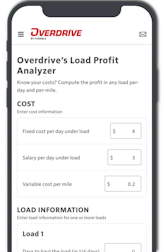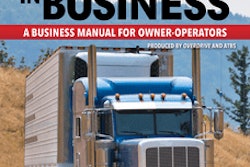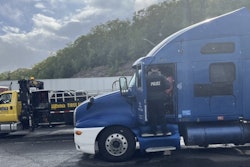After a groundswell of advocacy from truckers across the country and several horrific crashes, President Donald Trump responded with what he called a "commonsense" move to return truck drivers' required English language proficiency standards to prominence.
So far, neither Trump nor the U.S. Department of Transportation have offered a conclusive, data-based safety case to show non-English speaking drivers are actually less safe. But a new study may have proven that "commonsense" right.
Overdrive in August reported that, based on federal data on crashes and violations mined by Overdrive parent company Fusable's MC Advantage, motor carriers with an ELP violation get in more crashes than those with speeding or even drug-and-alcohol violations.
According to that report, motor carriers with a violation of 391.11(b)(2), the part of the Code of Federal Regulations that requires drivers "read and speak the English language sufficiently," have been involved in DOT-recordable crashes at about double the national average rate.
This month, new research from a supply chain expert at the University of Tennessee examined whether ELP violations are associated with unsafe motor carriers. The research was conducted by Alex Scott, associate professor of supply chain management, Cheryl Massingale Business Faculty Scholar and the Gerald T. Niedert Professor in the Haslam College of Business at the University of Tennessee.

Scott has a long history in trucking that goes back more than 20 years. His first work out of college was with J.B. Hunt Transport, and he spent 10 years working “in transportation logistics and consulting,” he said, before he “went into academia and got a PhD. ... All my research for 12-plus years has been on trucking, and I generally like to look at safety," as well as regulations and sustainability topics, he said.
[Related: Non-English speaking carriers more dangerous than drug, speeding violators: Study]
When ELP began emerging as a hot-button issue this year, Scott took notice. “It’s not that often that presidents put executive orders specifically on the trucking industry,” said Scott. “So that kind of inherently makes it interesting. It brings a natural question as to whether the carriers and the drivers that are failing, or getting violations for English language proficiency, whether they would be having worse inspections in general,” or what kind of safety records those carriers have.
Scott’s research paper, available to download here for free, examines whether carriers that have ELP violations have worse safety records than those without. The paper also looks at individual roadside inspections that find ELP violations and measures if they occur alongside more non-ELP violations than inspections where the driver readily spoke English.
After digging into the data, Scott came to three conclusions:
- Inspections with ELP violations have more overall violations (exclusive of ELP violations) compared to inspections without ELP violations.
- Carriers with ELP violations have worse than average safety scores, especially for the Vehicle Maintenance and Unsafe Driving categories in the FMCSA CSA system.
- There was a steady uptick in ELP enforcement in June and July, but not everywhere -- California largely ignored the order. (Overdrive saw similar trends when evaluating violation data from sister company RigDig Business Intelligence.)
To conduct his research, Scott used FMCSA data on roadside inspections and violations from May 1 through Sept. 21. He also used CSA category measures/scores from the same time period to evaluate carrier safety.
[Related: DOT penalizes California $40M over repeated refusal to enforce English language regs for truckers]
Based on his findings, Scott couldn’t conclude that ELP violations cause higher violation rates and/or safety scores generally, he said, but there is certainly a correlation between ELP violations and higher violation rates and safety scores.
“ELP violations are associated with unsafe carriers, and you could say 'unsafe drivers'" because, on average, they "have more violations per inspection,” he said. “… I’m not saying ELP, the lack of speaking English makes you a worse driver, I'm not saying that. … I don’t know the causality here, but all we can say is that they are related and it's quite clear.”
Scott’s report concluded that there are at least two possible explanations for the correlation:
- If a driver cannot speak English, then the driver “is unlikely to be able to understand the extensive federal rules and regulations governing trucking,” possibly also contributing to a lack of understanding of maintenance or how hours-of-service rules work.
- It’s also possible that non-English speaking drivers are taken advantage of by unscrupulous carriers and managers at those carriers and are pushed to operate unsafely.
Details on how Scott reached his conclusions follow.
ELP enforcement trends
Enforcement of ELP as a violation began to tick up slightly in April and May before “you see a ramp up in June and July, and then you see it kind of steady out through September,” Scott said. The peak, he found, was around 6,000 violations per month. Prior to the executive order, ELP violations (non-out-of-service) were being issued, but averaged less than 1,000 per month.
Scott found that federal inspectors issued ELP violations at much higher rates than state inspectors, with violation rates 3.5 times higher than the highest state (Wyoming).
Scott’s research found that Wyoming, Texas and Arizona had the highest percentage of inspections with ELP violations among states. Looking at all ELP violation numbers, Texas led the way by a large margin with 4,416 ELP violations reported, compared to 514 for Arizona, which was the next-highest state.
[Related: Trucking English language enforcement: The toughest and most lax states]
California had the lowest rate of ELP violations and “was practically not enforcing it at all,” Scott said. “The percentage of English language violations in an inspection was .005% in California. You can compare that to something like 5% or 4% for like Wyoming or Texas.”
Even more striking to Scott, he said, was that when he compared ELP violations from January to May then May to September, “California found more violations from January to May than from May to September, which tells you they’re clearly ignoring the executive order.” His report notes that “California inspectors reported eight ELP violations out of 176,074 inspections” from the May to September period and that “federal inspectors found ELP violations at a rate almost 1,900 times higher than California.”
[Related: Enforcing Trump's English language mandate 'not part of California law': CHP]
Violations in inspections
The next part of Scott’s research looked at how many other violations were found during inspections that had an ELP violation compared to violations found in inspections without an ELP violation.
“So, inspections with English language violations -- but I’m tossing those violations out when I’m counting -- and then a comparison group of those without English language violations,” he said.
The results are striking -- inspections with an ELP violation had an average of 3.9 other violations, while non-ELP-violation inspections had an average of just 1.69 violations.
The difference is “substantial in total violations, it’s substantial in driver violations, it’s substantial in out-of-service violations, driver out-of-service violations, vehicle out-of-service violations across the board,” Scott said. “You find substantially more violations per inspection for the inspections that have ELP violations versus the inspections that do not have ELP violations. And it’s not really very close.”
For OOS violations, “inspections with ELP violations had driver OOS violation rates almost three times that of inspections” without ELP violations, the report notes.
[Related: Trucking English language enforcement: The toughest and most lax states]
Carrier safety ratings based on ELP violations
The last part of Scott’s research looked into the safety ratings of motor carriers with and without ELP violations to compare them. His finding? “The safety ratings of the carriers with ELP violations were considerably worse on average than carriers without ELP violations.”
He primarily looked at three BASIC categories in his comparison -- Unsafe Driving, Hours-of-Service Compliance, and Vehicle Maintenance.
“What you find is that the carriers with ELP violations have substantially worse safety scores for those three categories … than carriers that do not have ELP violations, and it’s quite stark in some cases,” Scott said.
The average Vehicle Maintenance measure score for carriers with ELP violations was 9.06, compared to an average of 3.33 for all for-hire, interstate, non-passenger carriers rated by the Federal Motor Carrier Safety Administration. The score for Unsafe Driving was 6.23 for carriers with ELP violations, compared to a 1.77 average for all for-hire, interstate, non-passenger motor carriers. HOS compliance was still worse for ELP violation carriers, but not nearly as stark -- an average of 0.71 HOS measure for ELP carriers compared to 0.58 for the industry average.
[Related: Bill to codify ELP requirements for truck drivers: Senate version]














